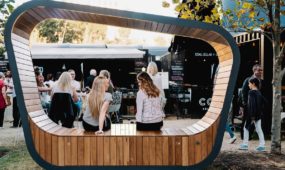All wrapped up
Innovation
COMBINING a popular Chinese street food with a modern franchise model has turned out well for a South Australian entrepreneur with a solid business plan.

Sign up to receive notifications about new stories in this category.
Thank you for subscribing to story notifications.
Ming Liang Ma has taken his Bing Boy urban Asian crepe stores from one test location in a South Australian food court to more than 30 around Australia – and he's not stopping there.
“To establish and develop a franchise, it's always been my passion to do that,” says Adelaide-based entrepreneur and Managing Director, Ming.
Ming's determination has been rewarded with a stellar growth of 204 per cent this year, earning Bing Boy second place on the in-business.com.au Fast Movers ranking. According to in-business, the company had a a turnover of $4,871,940 in FY14.
Jian Bing, a sort of folded Chinese pancake, is a popular breakfast street food in Beijing and its rural surrounds.
After cutting his teeth in other food franchises, Ming had the idea to introduce the Jian Bing, with some modern twists, to a new audience in Australia.
“Bing itself as a product is absolutely new on the market,” Ming says, “It has some similarities with the French crepe, it's a little similar to Yiros as a wrap, but the combination of how we cook it, how we wrap it and deliver it to the customer, that's quite new.”
Bing Boy has undergone a measured yet rapid expansion since the first store opened in Southern Cross Arcade in Adelaide in June 2011, growing to 14 stores in its first two years.
That more than doubled in 2013-14 to 30 stores, made up of 14 in South Australia, 14 in Victoria and three in Queensland. Over the next year, Ming wants to see another 20 restaurants open across Australia and he recently opened his first stand-alone shop in the refurbished Rundle Mall in Adelaide.
“Before we even opened the first store, I planned it as a franchise business already,” he says. “When we designed the store, the logo, the name and everything, it's all related to the franchise's expansion down the track.”
The franchise’s first year was dedicated to developing a system for running the business and franchises, as well as testing the products, locations and markets.
Key to these processes and developments are the teams of people in design, operations working with Ming. For him, investing in the people around him and developing their skills is absolutely key to the business' success.
“Part of this process is developing internal teams, sending them to different training courses and mentoring programs. I've been very fortunate. I do have a good team of people working around me,” he says.
The first store served as a test for the ideas at the foundation of Bing Boy. When the second store opened, it took off – which gave Ming the confidence to expand and innovate.
“There are a lot of things you can't predict. Even though my teams and I sat down with a designer and went through marketing materials, design, layout, operations, there's a lot we change,” Ming says.
One of the first areas to come under scrutiny was their packaging. After observing the rather messy process of wrangling a Bing in its plain wrapping paper, the team came up with perforated paper that tears off in stages as the customer makes their way through a meal.
“We develop as we grow. Even now we still change a lot of things in terms of operations and design,” Wang says.
Their second and third years marked Bing Boy's larger expansions interstate. He admits this was a challenge – something that defied conventional wisdom on the topic.
“We keep hearing people say if you can run a business in Adelaide and be successful, you can be successful anywhere else in the country. I have a bit of a different view.
“Because we're locals in Adelaide we feel we know the market more. When we move to other states there are certainly a lot of opportunities, no question, but the competition, understanding the market and location geographically, that requires a lot more work.”
Recruiting franchisees will become a major focus in the coming years. The last few had Bing Boy concentrating on operating the business and developing the systems, but that attention is shifting.
Ming understands that key to a franchise’s success is growth and presence – in this case, through franchisees. Tempering that, however, is upholding the brand's image and standards.
It means that a potential Bing Boy franchisee has a fairly extensive and exacting process ahead of them, but one that ensures the chain's name is held in good stead.
“We are always trying to find a better franchisee system. We have two interviews as well as psychological testing. The second part is training. There's online and office training as well as on-site training, and ongoing training once they've started.
“Further to that we have a supervisor to help a franchisee open a store, to sort of hold their hands to get it settled. We also have external consultants give them three month, six month and 12 month reviews – to make sure they understand not only operating a store, but also the HR and business areas,” he says.
There's the further requirement that a franchisee has to be a hands on owner-operator with the business, rather than an outside investor – expected to put in at least 30 hours a week for their store. To save drama, perhaps, there's also the caveat that it has to be solely owned – or within immediate family.
Ming’s other challenge is growing awareness of the Bing Boy brand. The trouble, he says, is that people talk about their product, the Bing, more than the name 'Bing Boy'.
“We've been working on brand positioning. We want to work on what Bing Boy means to consumers rather than the Bing product itself,” Ming says.
This is the result of two things.
One, that their product is entirely new on the market. Ming isn't trying to sell another burger or sushi shop, where the brand name is the distinguishing factor. He's selling a food new to the market where the product itself is what distinguishes it from competitors.
Secondly, their initial challenge was selling people on the idea of the Bing. And in that, Ming and his team were very successful.
“There are some people that are willing to try new things. There are also people cautious about what they eat. The way we solve that is we give a lot of samples to the customer. We found that so far, that's the most successful local marketing we've done,” says Ming.
Bing Boy's marketing efforts are being redoubled in the coming year. Their challenge is that, as a younger, smaller brand than most on the market, they probably can't compete in the channels popular with the big chains.
“A commercial wouldn't be our first preference. Local marketing is still our first preference. The sampling alone works out really well for us, but the brand awareness is still pretty low.
“When we get the customer to experience and try the product, we then need them to acknowledge there is a Bing Boy store in the sense that it's a place. That's something we need to work hard on,” he says.
Bing Boy is also be experimenting with an on-street location rather than their usual food court model. They launched their first street store on November 29, in Rundle Street in the Adelaide CBD.
“Rundle Street is one of Adelaide’s busiest and most popular places to eat, drink and shop, so we’re looking forward to tapping into that and introducing our popular bings to a new band of customers.”
For Ming and his team it's an exciting chance to try new things. Longer trading hours and different locations will give them a whole new perspective on the business' expansion.
“We have to have innovation all along the way,” Ming says, “Otherwise the business will die.”
Jump to next article



